Introduction
Polyvinyl Chloride, commonly known as PVC, is one of the most versatile and widely used polymers in various industries. Its applications range from construction and healthcare to electronics and retail product displays. However, PVC’s inherent brittleness at low temperatures can limit its utility in cold environments, such as in outdoor applications or refrigerated settings in supermarkets. To overcome this limitation, manufacturers often modify PVC with toughening agents. This article explores the types of toughening agents used for PVC, their impact on the polymer’s properties, and their applications, particularly in scenarios demanding durability in cold conditions.
Understanding PVC and Its Challenges in Cold Environments
PVC is a thermoplastic polymer that is prized for its durability, resistance to corrosion, chemical stability, and affordability. However, its tendency to become brittle in cold temperatures poses challenges. When exposed to low temperatures, the molecular mobility of PVC decreases significantly, leading to increased brittleness and risk of cracking under impact.
The Role of Toughening Agents
Toughening agents are additives that improve the impact resistance and flexibility of polymers without significantly compromising other properties like strength and transparency. For PVC, the choice of toughening agent is crucial as it must accommodate the polymer’s unique characteristics and the specific demands of its application environment.
Popular Toughening Agents for PVC
- Acrylic Impact Modifiers: These are copolymers of acrylic monomers that provide excellent weatherability and color stability, which are essential for outdoor applications. They improve the toughness of PVC by creating a rubbery phase within the polymer matrix that helps absorb and dissipate energy during impact.
- Chlorinated Polyethylene (CPE): CPE is highly compatible with PVC and is used extensively as a toughening agent. It enhances the impact strength and flexibility of PVC by providing a ductile phase that helps to prevent crack propagation at low temperatures.
- ABS Resin: Acrylonitrile Butadiene Styrene (ABS) is a terpolymer made by polymerizing styrene and acrylonitrile in the presence of polybutadiene. Mixing ABS with PVC not only improves toughness but also enhances the aesthetic qualities of the products, which is vital for consumer-facing applications.
- Elastomeric Modifiers: Rubber or elastomeric modifiers like NBR (Nitrile Rubber) or TPEs (Thermoplastic Elastomers) are used to impart flexibility and improve the impact resistance of PVC. These modifiers are particularly effective in absorbing impact energy, thereby reducing the likelihood of failure under stress.
Process of Incorporating Toughening Agents in PVC
The incorporation of toughening agents into PVC typically involves blending the agents with PVC resin during the compounding phase. This process is critical and must be carefully controlled to ensure uniform dispersion of the toughener, which is vital for achieving consistent material properties. Techniques such as high-shear mixing or twin-screw extrusion are commonly employed.
Applications of Toughened PVC in Cold Environments
Toughened PVC finds extensive use in applications where durability and performance in cold weather are critical. Some of the primary applications include:
- Outdoor Piping and Fittings: Toughened PVC pipes are ideal for cold climates as they resist cracking under freezing conditions.
- Automotive Components: In colder regions, automotive parts made from toughened PVC, such as gaskets and seals, offer reliability and longevity.
- Retail Product Displays: For supermarkets and stores with refrigerated sections, display units and shelving made from toughened PVC can withstand the rigors of cold temperatures without degrading.
- Electronic Enclosures: Toughened PVC is used in housings for outdoor electronics, providing protection against physical impacts and the stress of thermal cycling in cold environments.
Benefits for Specific Industries
- Supermarkets and Retail: Improved durability and aesthetics of display units enhance customer interaction and product visibility, even in refrigerated or outdoor settings.
- Automotive Industry: Toughened PVC components contribute to safer and more durable vehicles, capable of withstanding harsh winter conditions.
- Construction and Infrastructure: Use of toughened PVC in outdoor construction materials helps in reducing maintenance costs and increasing the lifespan of the structures in cold regions.
Conclusion
The modification of PVC with toughening agents represents a significant advancement in polymer technology, particularly for applications that require robust performance in cold environments. By selecting the appropriate toughening agents and employing precise compounding techniques, manufacturers can significantly enhance the durability and versatility of PVC. This not only meets the functional requirements of various industries but also addresses environmental challenges, ensuring that PVC remains a material of choice for a wide range of applications.



